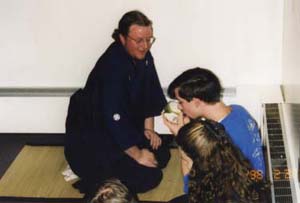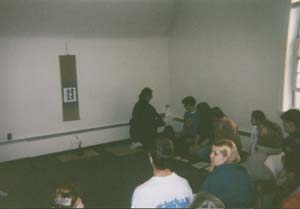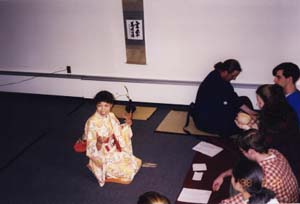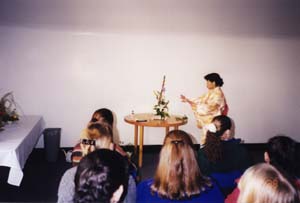Sado
International Festival in February 28th, 1998
Exhibition of flower arrangements by Prof. Ofuji and tea ceremony by Greg Stoddard ’98 who took lessons in tea ceremony in Japan in the winter of 1997
茶道(The Way of Tea)
 |
Greg, serving a bowl of tea to Tony Duffy ’98 as “Shokyaku (a main guest).” Greg’s costume is a traditional “kimono,” “hakama (pants),” and “tabi (socks).” |
| Greg brought back necessary utensils such as tea bowls, a whisk, “kama (kettle),” “hibachi (brazier),” “hishaku (bamboo ladle), ” “kakejiku (hanging scroll),” etc. from Japan. The “Ocha-bana (Tea flowers) were arranged by Prof. Ofuji. |
 |
 |
 |
Welcome! –GREG’S MESSAGE FOR HIS TEA CEREMONY–
“Needless to say, today’s ceremony will be a poor imitation of a traditional ceremony; surroundings are less than ideal. The tea ceremony is usually held in a small room (about 8×10 feet) built solely for the purpose of Tea. The floor is covered in thick woven grass mats, and the room is immaculately clean. The tea ceremony is ideally shared with 2-6 people, although more are possible.
This singularity of place and intimacy of participants gives rise to a truly unique phenomenon of experience. In the space between tea master and guests, a feeling akin to peace, yet pulsing with life emerges… The somber joy, sad happiness, and informal formality is inexplicable. It is a religion made up entirely of the drinking of a green beverage.
And people study for decades to learn how…
* * * * * * * * * * *About the scroll and other objects…
The Japanese writing hanging from the scroll in front of the room, illegible even to most Japanese viewers, is usually explained by the person giving the tea ceremony. This particular one might be read, “Quietly, in the tea room, enjoy the pure taste of the Tea.” The individual characters, read from top-to-bottom, right-to-left, read: Room, Quiet, Tea, Taste, Pure. You can construct any meaning you wish, either from the meaning of the characters or the motion and energy of the script itself.
The kettle is a spring/summer kettle, and we use it here both out of necessity, and as an attempt to look forward to the seasons which are beginning to mix themselves into the winter air.
Please take a folded paper with a sweet on it, large paper if you are male, and small if you are female, and take a seat when you feel comfortable.
** * * * * * * * * *procedure for tea ceremony
The guests in the tea ceremony are not receiving the gift of a ceremony from the tea master, but are rather sharing in the experience, contributing their presence, and affirming the spirit of equality that exists in the tea room.
There are a few things it is good for a guest to know, such as how to drink the tea with the proper steps…
First, one person must be chosen by consensus as the “Shokyaku” or main guest [in the above picture, Tony Duffy is the Shokyaku]. The Shokyaku kneels at the entrance to the tea room, bows, stands, enters the tea room, kneels in front of the tokonoma (place with the scroll) bows, and then, while keeping his/her hands on the floor examines and appreciates the art which is situated there… Take your time… Soak it in… After you are done, bow once more, take a sweet on a folded paper (large paper if male, small if female) and take your place to the right of the large iron kettle… Sit, relax…
The other guests follow suit, one at a time, until everyone is seated.
I’ll enter, do a bunch of stuff, and eventually, you will be served a bowl of tea….
People usually eat the sweet just before they are served the tea…
The person who serves you the tea will set it in front of you, and shuffle back a bit, She will bow, and so will you… Carefully pick the bowl up with your right hand, and move it closer to you. Set it down. Look at me, and say, “I humbly partake of the ceremony” Bow… I’ll do the same…
Pick up the bowl again with your right hand. And set it on your left hand, switch your right hand grip to horizontal. Raise it to eye level, look at the front, and then rotate it a quarter-turn clockwise to avoid drinking from the front…
Now you get to finally drink the tea… enjoy.
Set it down in front of you.
Pick it up again with both hands…. Look at it closely, appreciate the artistry of it, take your time, here….
Place it in front of you, so the front faces away from you…
Relax….
Confused? No problem… you have a cheat sheet…”
Books recommended
茶の本 (The Book of Tea) in Japanese. There is a translation —
” The Book of Tea” by Kakauzo Okakura (1862-1913) ; With foreword & biographical
sketch by Elise Grilli.
CONTENTS: The cup of humanity — The schools of tea — Taoism and Zennism —
The tea-room — Art appreciation — Flowers — Tea masters.
**There are a few copies available in the libraries at Bowdoin and Colby.
“Greg was very impressed by ‘Cha no hon’ because in this book Okakura says that ‘sado’ is the Oriental democracy. I agree with him and hope more people, both Japanese and non-Japanese, will read this book. (Ofuji)”
華道 (The way of Flowers) or 生け花 (Flower Arrangement)
 |
I (Ofuji) took lessons in the Ohara-ryu (school) for many years in Japan and got a certification for teaching “ikebana.” The Ohara school was founded at the end of the 19thcentury by Ohara, Unshin. The Ohara school has popularized the “moribana (lit. piled flowers).” I like this school’s style very much because they have developed their own arrangements based on the traditional Japanese styles and modern styles of Ikebana. The flower arrangement in the picture is the Heavenly Style of “moribana.” |
Brief History of “Ikebana”
To capture the natural beauty of the fields and hills–the various greens and colors of flowers and trees.
To share this with others, especially long-awaited special guests.
Such are the thoughts that must have prompted men even in ancient times, as they do today, to select blooms or branches and place them on display.
With time, in arranging flowers and branches, one becomes aware of the very different results obtained by merely changing the position of a branch, the placement of the flowers, the number used, the shape, color combination and the blending of materials. This naturally leads to the question–what kind of arrangement, and what combinations of materials, best bring out or emphasize the natural beauty of the flowers and branches being arranged? In Ikebana, one of the traditional arts of Japan, these questions have been seriously pursued and discussed for hundreds of years. The combined achievements of thousands of individual Ikebana devotees, building one upon the other through these many years, have resulted in the present day techniques of Ikebana.
Ikebana took form in the Muromachi Period (1390-1573). The Muromachi Period’s cultural characteristics are represented in a combination of art forms known as the Higashiyama Culture. This Higashiyama Culture initiated the tea ceremony, the Noh drama, “renga” form of linked poems, architecture, and garden landscaping, most of which are called the traditional cultures of Japan. Ikebana also took more disciplined form in this period. Prior to that, from the time of the Nara Period (8th century), there were only floral offerings which were the earliest beginnings of Ikebana.
[“Ikebana for Everybody” by Houn Ohara, published by Ohara School, 1975.]
MUSIC TAKEN FROM THE ART OF THE JAPANESE BAMBOO FLUTE AND KOTO BY YAMATO ENSEMBLE COURTESY OF ARC MUSIC INCORPORATED.
AVAILABLE BY MAIL ORDER AS
EUCD 1248 FROM ARC MUSIC INCORPORATED, P.O. BOX 2453, CLEARWATER, FL 33757-2453
E-MAIL
WEBSITE